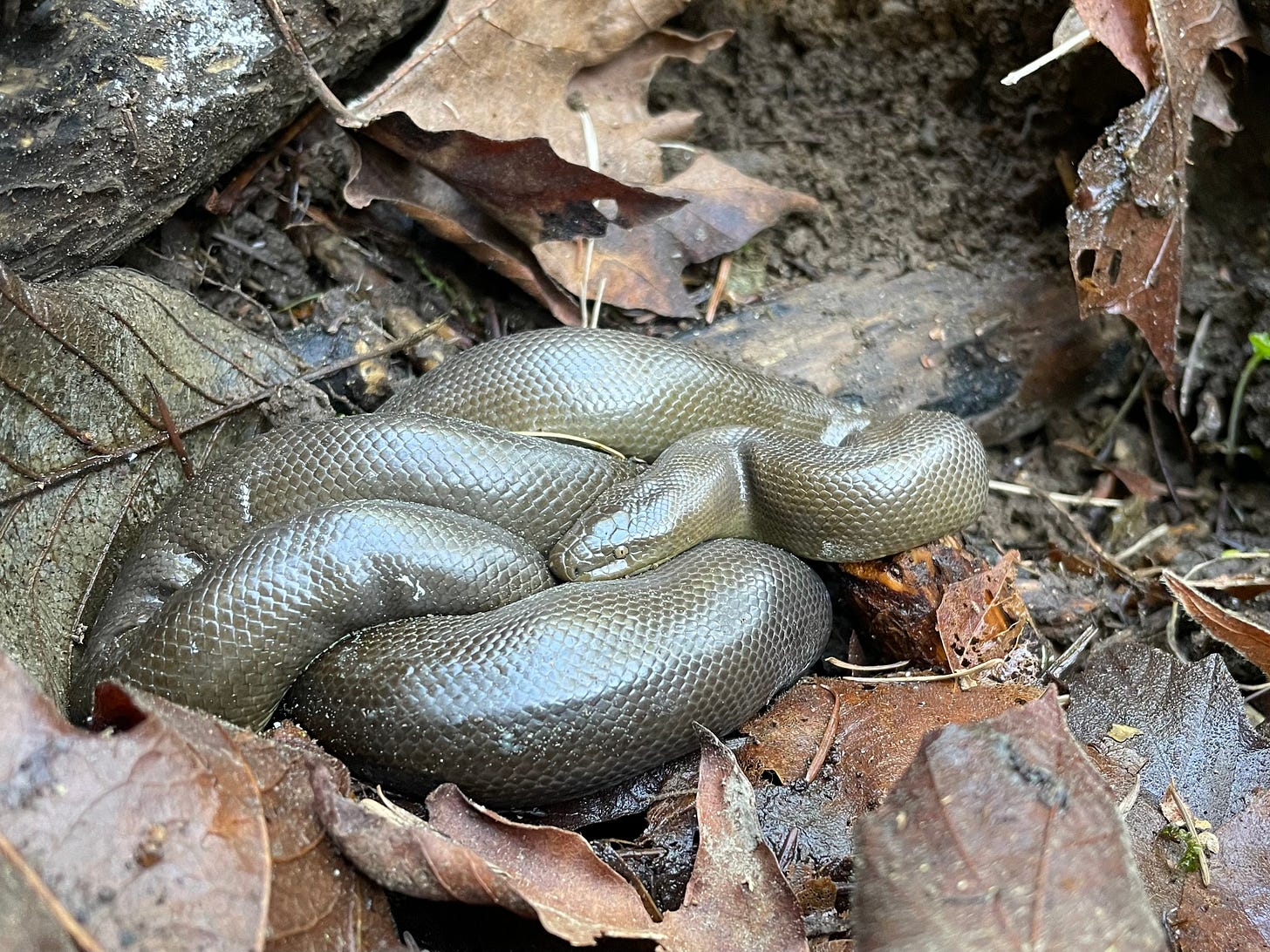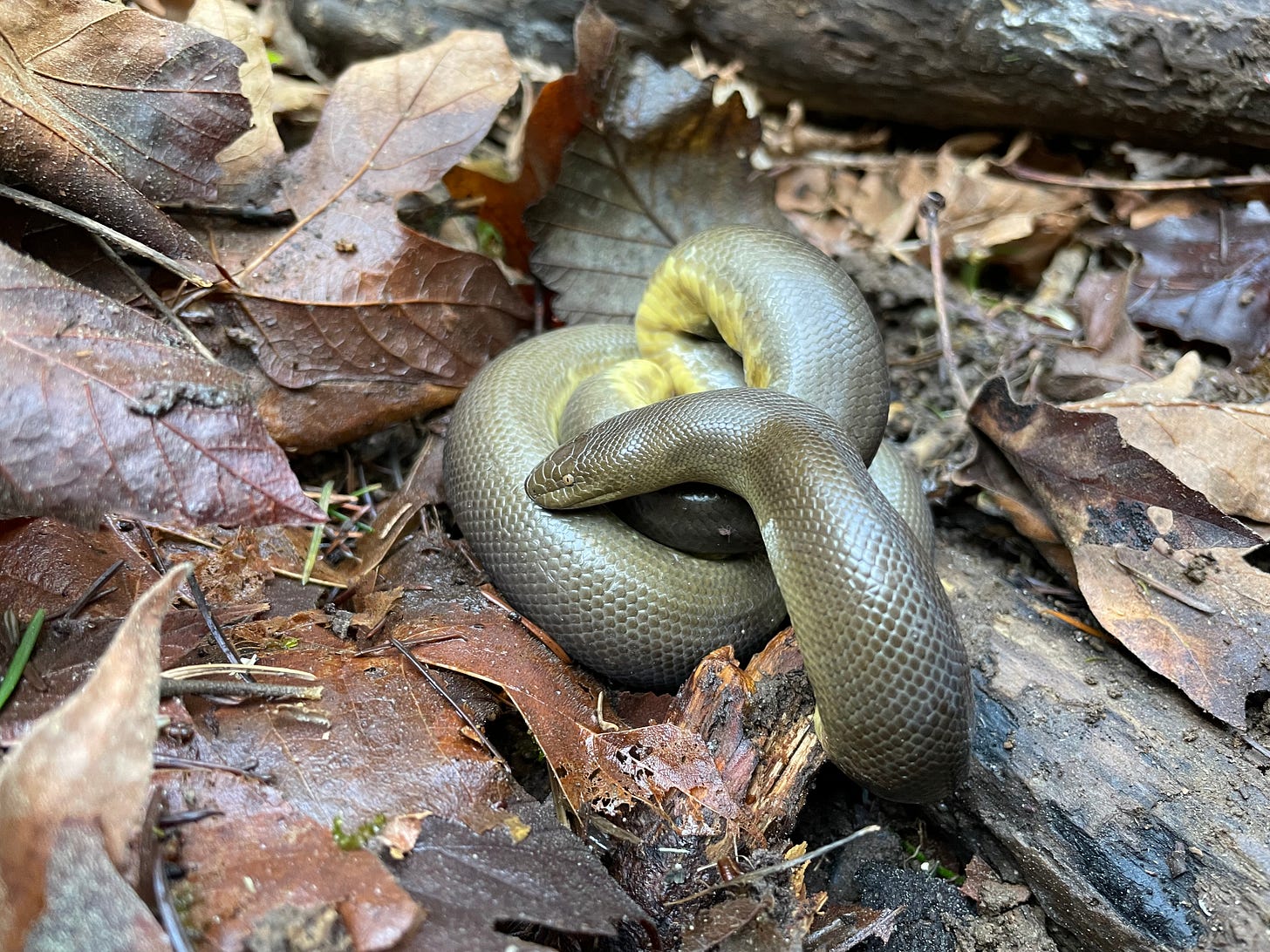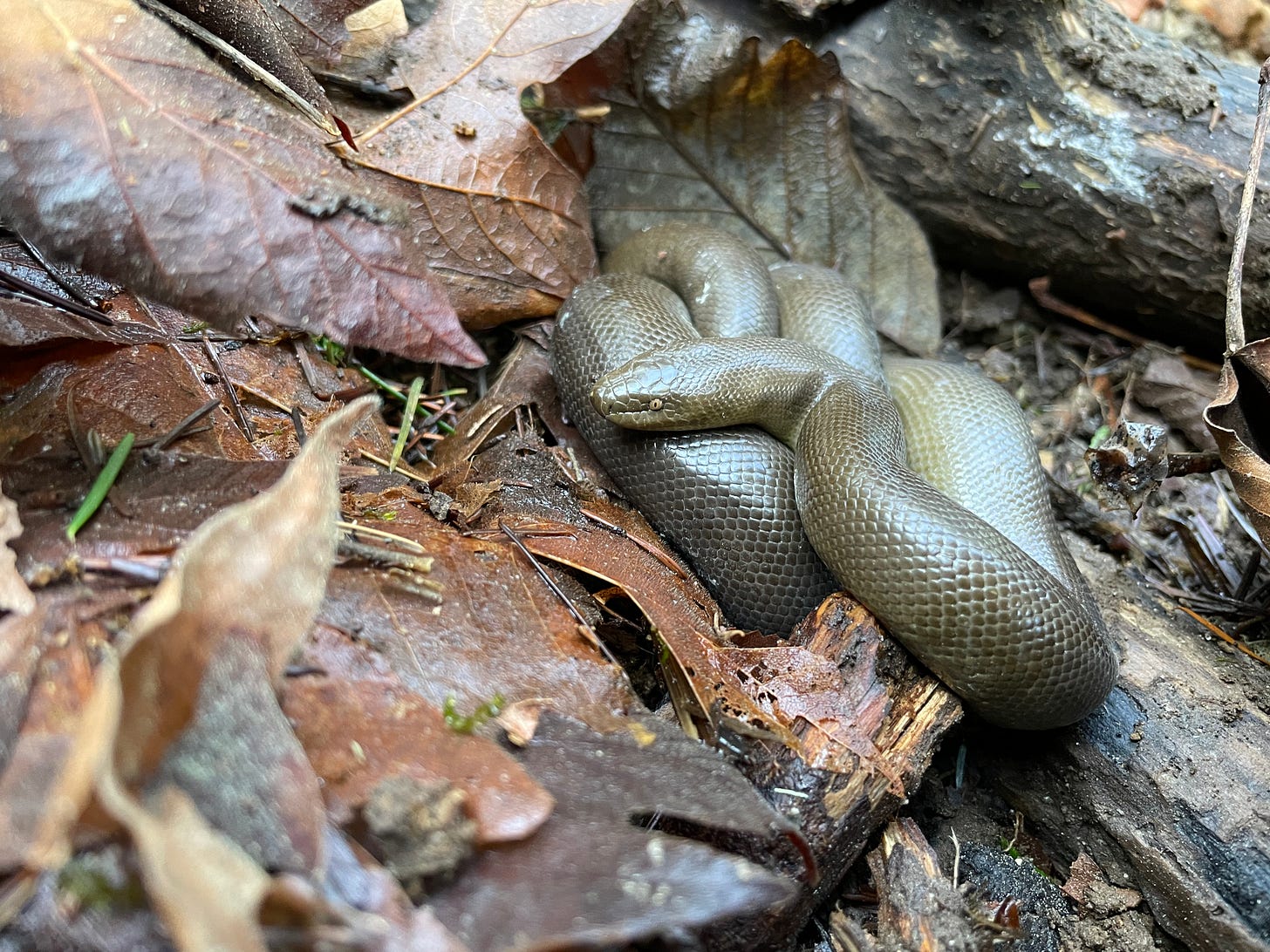The boa is wedged in a crack between a chimney of big round stones from the beach and the room’s old drywall. Head down, most of its two-foot length can only be seen as a darker shadow in the crack. Near its tail, where a chimney stone juts, it loops into the room, motionless.
My neighbor, who called me to the scene, says at first glance he took it to be some kind of iron hook for a fireplace tool. His second look laid that notion to rest. My first instinct is to touch it. With a fingertip I do. It is smooth, soft, the skin a little loose, almost velvety, and it barely recoils. Of all the places to at long last have an encounter with this near-mythical snake, the rubber boa, it is here in an unoccupied and water-damaged home on an ivy-choked bluff above the Sound.
It is bigger than I expected, the thickness of a garden hose. It is our only native snake that is not a garter snake, and it is a constrictor. I’m giddy.
One of a rubber boa’s reported defenses is a secretion said to be on par with skunk spray, and as I begin to tease the snake from the crack a milky liquid runs from its cloaca. The smell hits. It is pungent, sure, but as my neighbor makes for the door and the snake resists my tugs, it strikes me that the smell is more like seafood than anything, like strong clams. Then it’s bearable.
At first I worry that pulling the rubber boa’s tail might cause its head to get stuck, but the strange rubbery skin shifts and the entire snake slips free, its head no wider than its body. It has an almost wormlike profile, its tail just as blunt as its head.
It has been called the two-headed snake. It is not known to strike when handled. Indeed, its next defensive move, as it slowly curls in my hands, strangely placid, is to bury its head beneath its coiled body and leave its tail loose. I cannot think of another wild animal I have handled that is this calm in the hand. The few biologists who have attempted to study rubber boas have found tail scars to be common, evidence that the snake’s predators are fooled into thinking that the free end is the head.

Rubber boas are difficult to find. They are nocturnal and fossorial, meaning they move at night and live mostly underground.
Yet their range is large, from British Columbia to California and east to Utah and Wyoming, suggesting a fairly adaptable creature, and they are found in forests, grasslands, and scrubby areas from sea level to 9000 feet elevation.
It is wild that few studies have been conducted on the only boa in most of the American West. Our understanding of its diet, predators, reproduction, and seasonality are based on disjointed snapshots and chance encounters.
To me it’s yet another example of how much life plays out beyond the edges of our perception. How many rubber boas live on the Key Peninsula? Where are they concentrated? Is the population healthy? Who knows. So many creatures may or may not be doing fine.

Here is some of what is known, most of it thanks to a few dedicated biologists in Oregon. Rubber boas spend most of their time in rodent burrows. Young rodents seem to be their primary food, though they take birds, eggs, snakes, and lizards as well. They hibernate throughout the cold season. When temperatures are marginal, they use the sun’s warmth to raise their body temperature, though not on the earth’s surface. They choose a thin rock or slab of bark and practice what is called subsurface basking. One of the best methods to find a rubber boa is to put pieces of metal roofing out as artificial cover and check underneath them regularly. When the temperature grows too warm, rubber boas retreat back underground.
A few predators have been confirmed, including Red-tailed Hawk and Barred Owl as well as several snakes that do not live in our area. One rubber boa was found coiled around the neck of an alligator lizard while the lizard was biting the snake’s head — it was unclear who was predator and who was prey.
Like most boas, rubber boas give birth to live young. They grow slowly. Females take at least four years to reach reproductive age. They do not have young every year. Everything about them is slow — ask the rodents they slowly squeeze to death. Animals with slow lifestyles, the geoducks and yews of the world, tend to be long-lived, and a hot-off-the-presses study using rubber boa data from a biologist who searched for them in the same sites for decades and used their variable scale patterns like zebra stripes to identify them as individuals, has confirmed that it is true for rubber boas as well.
Over 60 of the rubber boas in the study were estimated to be over 20 years old. Incredibly, one female was first caught as a large 27-inch adult in the summer of 1971. Growth models suggest she was already between 20 and 36 years old. The biologist continued to occasionally recapture her until 1989, when he brought her into a cage for study. She reproduced a number of times in captivity. Finally, in 2006, she died. So according to the models, she lived somewhere between 55 and 71 years. This would shatter snake lifespan records. It is exceptional to imagine.
As for the inert rubber boa in my hands, I carry it into the woods and find a brush pile where I nestle it against logs and cover it with leaves. It does not move. I wish I could do something more for it. I wish I could know its next move, what it needs, where it will go. But some things can only be left to their own devices.
Thank you for reading Infinite Peninsula. Subscribe to receive every ramble and adventure, become a paid subscriber to keep me going, and share with anyone who would dig a spy’s-eye view on the world we share with wildlife. What crack in the mortar will I investigate next?





Great story. Now, I'll to keep my eyes peeled to see them. Thanks.
Thanks for this, Chris. Rubber boas are amazing. I was lucky enough to see one while hiking on the Olympic Peninsula a number of years ago. It might have been Crescent Lake. I had no idea they were so long lived.